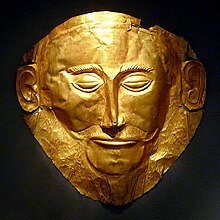Geography |
|---|
| Overview |
- Borders
- Cities (capital and co-capital)
- Extreme points
- Place names
|
|---|
| Regions |
- Central Greece (Aetolia-Acarnania (Aetolia, Acarnania), Attica, Boeotia, Euboea, Evrytania, Phocis, Phthiotis, Saronic Islands)
- Crete (Chania, Heraklion, Rethymno, Lasithi)
- Cyclades (Andros, Delos, Kea, Kythnos, Milos, Mykonos, Naxos, Paros, Santorini, Syros, Tinos)
- Dodecanese (Agathonisi, Astypalaia, Chalki, Kalymnos, Karpathos, Kasos, Kos, Leipsoi, Leros, Nisyros, Patmos, Rhodes, Symi, Tilos, Kastellorizo)
- Epirus (Arta, Ioannina, Preveza, Thesprotia)
- Ionian Islands (Corfu, Ithaca, Kefalonia, Kythira, Lefkada, Paxi, Zakynthos)
- Macedonia (Chalkidiki, Drama, Florina, Grevena, Imathia, Kastoria, Kavala, Kilkis, Kozani, Pella, Pieria, Serres, Thasos, Thessaloniki)
- North Aegean islands (Chios, Ikaria, Lemnos, Lesbos, Samos)
- Peloponnese (Arcadia, Argolis, Corinthia, Laconia, Messenia, Achaea, Elis)
- Thessaly (Karditsa, Larissa, Magnesia, Trikala, Sporades)
- Thrace (Evros, Rhodope, Xanthi)
|
|---|
| Terrain |
- Canyons and gorges
- Caves
- Geology
- Islands (Aegean, Ionian, Crete)
- Mountains (Olympus, Pindus, Rhodopes)
- Peninsulas
- Plains
- Volcanoes
|
|---|
| Water |
- Coasts
- Lakes
- Rivers
- Mediterranean Sea
- Aegean Sea (Sea of Crete, Icarian Sea, Myrtoan Sea, Thracian Sea)
- Ionian Sea
- Libyan Sea
|
|---|
| Environment | |
|---|
|
|
Society |
|---|
| Demographics |
- Diaspora
- Greeks (names of Greece and the Greeks)
- Immigration
- Minorities (Muslim minority, Jews, Arvanites, Aromanians (Aromanian question), Megleno-Romanians, Slavophones, Roma)
- Women
|
|---|
| Culture |
- Anastenaria
- Caryatid
- Clean Monday
- Concept of kingship
- Dress (Chiton, Chlamys, Exomis, Fustanella, Himation, Mariner's cap, Peplos, Perizoma, Tsarouchi, Vraka)
- Eastern Party
- Festivals
- Greek East and Latin West
- Greektown
- Hellenization
- Hospitality
- Carols (Christmas, New Year's, Theophany's)
- Mangas
- Mountza
- Naming customs
- Paideia
- Philhellenism and Hellenophobia
- Plate smashing
- Philosophy
- Philotimo
- Public holidays (Independence Day, Ohi Day)
- Rouketopolemos
- Souliotic songs
- Theophany
- Tsiknopempti
- Units of measurement
- Worry beads
|
|---|
| Art |
- Architecture (Castles)
- Cretan and Heptanese School
- Modern art (19th century)
- Theatre (Ancient)
- Religious art
|
|---|
| Cuisine |
- Breads (Daktyla, Kritsini, Lagana, Paximadi, Tsoureki)
- Desserts (Diples, Halva, Koulourakia, Kourabiedes, Loukoumades, Melomakarona, Pasteli, Spoon sweets, Vasilopita)
- List of dishes
- Drinks (Mastika, Metaxa, Ouzo, Rakomelo, Sideritis, Tentura, Tsipouro, Tsikoudia, Frappé coffee)
- Cheeses (Anthotyros, Feta, Graviera, Kasseri, Kefalotyri, Ladotyri, Manouri, Metsovone, Mizithra)
- Filo (Amygdalopita, Bougatsa, Galaktoboureko, Karydopita, Spanakopita, Tiropita)
- Greek salad (Dakos)
- Meze
- Pasta (Gogges, Flomaria, Hilopites)
- Restaurants (Kafenio, Ouzeri, Taverna)
- Sauces (Skordalia, Taramosalata, Tirokafteri, Tzatziki)
- Souvlaki
- Varieties (Heptanesean, Cretan, Epirote, Macedonian)
- Wine (Agiorgitiko, Aidini, Assyrtiko, Athiri, Kotsifali, Lesbian, Limnio, Mavrodafni, Mandilaria, Malagousia, Malvasia, Moschofilero, Retsina, Robola, Savatiano, Vilana, Xinomavro)
|
|---|
| Languages |
- Greek alphabet (History, Orthography, Diacritics, Braille, Cyrillization, Romanization (Greeklish)) and numerals
- Greek language (Demotic, Katharevousa) and dialects (Cappadocian, Cretan, Cypriot, Maniot, Pontic, Tsakonian, Yevanic)
- Greek Sign Language
- History (Mycenaean Greek, Ancient Greek, Koine Greek, Medieval Greek, Modern Greek)
- Literature (Ancient, Medieval, Modern)
- Minority Languages (Albanian language (Arvanitika), Aromanian, Balkan Romani, Bulgarian, Ladino, Macedonian, Turkish)
- Place names and exonyms
- Proverbs
- Words for love
|
|---|
| Media | |
|---|
| Music |
- Church music
- Dances (Ai Georgis, Angaliastos, Antikristos, Ballos, Dionysiakos, Fisounis, Gaitanaki, Geranos, Hasapiko, Ikariotikos, Kalamatianos, Kangeli, Kastorianos, Kerkiraikos, Kleistos, Koftos, Pidikhtos, Leventikos, Maniatikos, Metsovitikos, Ntames, Palamakia, Partalos, Pentozali, Proskinitos, Pyrrhichios, Rougatsiarikos, Sirtaki, Sousta, Syrtos, Trata, Tsakonikos, Tsamikos, Zeibekiko, Zervos)
- Éntekhno
- Folk music (Cretan, Epirote, Heptanesian, Macedonian, Nisiotika, Peloponnesian, Pontic, Thessalian, Thracian)
- Hip Hop
- Ionian School
- Laïko (Skyladiko)
- Musical instruments (Askomandoura, Aulos, Bouzouki, Byzantine lyra (Cretan, Macedonian, Politiki, Pontic), Crotala, Floghera, Gaida, Harp, Laouto, Lyre, Organo, Pan flute, Phorminx, Psaltery, Salpinx, Santouri, Souravli, Tambouras, Tambourine, Trigono, Tsampouna, Tympano, Zilia)
- Rebetiko
- Rock (Punk)
|
|---|
| Religion and lore |
- Ancient religion (Origins, Modern Revival)
- Aerico
- Buddhism
- Catholicism
- Drosoulites
- Eastern Orthodox Church (Timeline: Antiquity, Early Middle Ages, Late Middle Ages, Early Modern Era, 19th century, Early 20th century, Late 20th century, Contemporary)
- Fairy tales
- Gello
- Greek Orthodox Church (Ecumenical Patriarchate of Constantinople, Church of Greece, Flag)
- Greek Old Calendarists
- Hinduism
- Hypertimos
- Islam
- Judaism (History)
- Kallikantzaros
- Lamia
- Mormo
- Mount Athos
- Mythology (Primordial deities, Titans, Twelve Olympians, Heracles, Odysseus, Jason, Oedipus, Perseus, Daedalus, Orpheus, Theseus, Bellerephon, Satyr, Centaur)
- Nymph
- Protestantism
- Psychai
- Sikhism
- Thymiaterion
- Name days
- Vrykolakas
- Wayside shrine
|
|---|
| Sport | |
|---|
| Symbols | |
|---|
|
|

